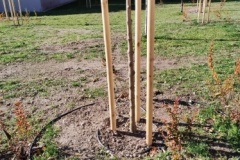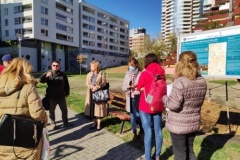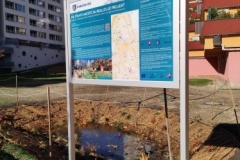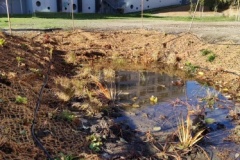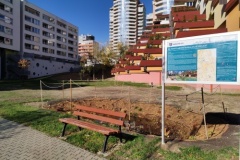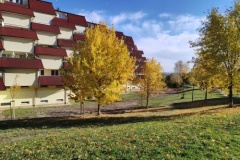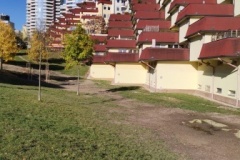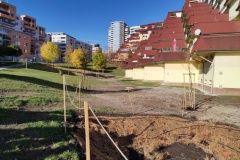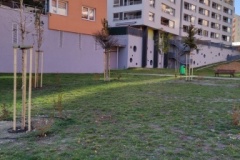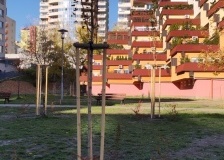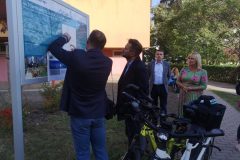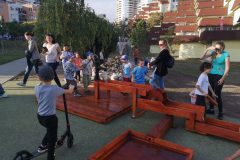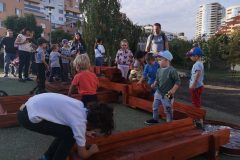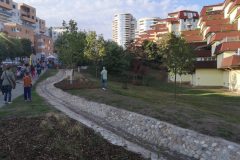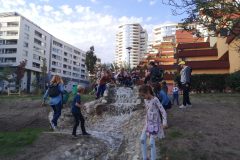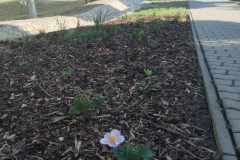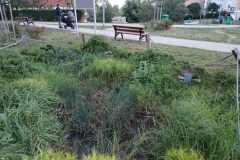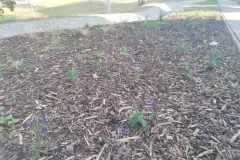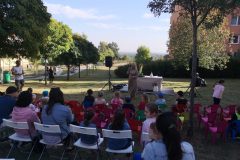Revitalization of the Kaskady public space
About the activity
The project will propose water retention and bioretentive, nature-friendly measures – infiltration systems to capture rainwater and replenish greenery resistant to climate change. These measures will be implemented in the public area of the Kaskady in the Municipality Bratislava – Karlova Ves in Dlhé Diely housing estate, which is one of the most vulnerable parts of the Municipality Bratislava-Karlova Ves from the point of view of climate change.
This area is mainly visited by families with children and the elderly. The activity is focused on model adaptation measures with the help of green infrastructure to solve problems associated with the negative effects of climate change – alternating periods of extreme drought with heavy torrential rains. For the first time (not only in Bratislava, but throughout Slovakia) we are testing a comprehensive approach, because we have developed a precipitation model of runoff routes and a dynamic simulation of the extent of floods, water depth and flow rates in Karlovy Vary. In accordance with this model, we chose the public space of the Kaskady, where the model shows great potential for the implementation of water retention measures (over 35 cm of rainwater in modeled precipitation of 31 mm / 30 min).
For this reason, several retention tanks and seepage beds will be built, integrated into the existing surrounding green space, which will be planted with various ornamental and at the same time resistant plants, which will improve the visual appearance of the park, improve the microclimate and provide support for biodiversity. The proposed measures provide for the irrigation of trees and shrubs with aic drip irrigation with trapped rainwater from underground reservoirs and with jet irrigation of lawns. In addition, 21 trees and trusses will be planted in the area to help cool the site and reduce CO₂ emissions.
Project activity indicators: reduction of emissions by 59.66 tCO₂ per life from 21 planted trees. Calculation: Robinia pseudoaccacia ´Umbraculifera´ – 45 years 1.45 t CO₂ / tree, Acer platanoides ´Crimson King´ – 45 years 1.02 t CO₂ / tree, Platanus occidentalis – 60 years 4.5 t CO₂ / tree.
What we have done so far
- November 2020 – December 2020: Public procurement documents for the elaboration of project documentation for the model revitalization of the Park Kaskady aimed at capturing, slowing down runoff and using rainwater, which ended up in a unified sewerage system together with wastewater were prepared (the costs of the project documentation were covered from the resources of the Interreg Europe and LIFE programs).
- January 2021 – March 2021: Comments on the project documentation were prepared, presentation on the planned model revitalization of Park Kaskady Park was prepared and online presented to the residents (March 10, 2021), so that residents could comment on it.
- April 2021 – May 2021: Agreement on Occasional Joint Procurement with the BROZ organization, partner of the DELIVER project, prepared; the wording of the Framework Agreement on the basis of pooling funds for the revitalization of Park Kaskady park prepared; public procurement documents for the contractor prepared.
- June 2021 – July 2021: Public procurement for the contractor was carried out, evaluated and the contract with the winner was signed.
- August 2021 – November 2021: Model revitalization of Park Kaskady was implemented (water from part of the residential building roofs and residential terraces is drained into two underground tanks, rain water id used for drip irrigation; 21 trees and 84 shrubs were planted, 7 grassed retention areas and 2 wetland beds were built). Protocol handover of the work on November 5, 2021.
-
April 2023 – Bratislava – Karlova Ves Municipality was successful in obtaining additional funds for the implementationof the 3rd stage of water retention measures in the Kaskády Park. In addition to retaining rainwater, which will be used to irrigate newly planted trees and shrubs, it is planned to build an artificial stream, a small water playground with a hand pump and a grinder for children. In the lower part, it is planned to build a wetland bed, planted with attractive plants. Completion of the works is planned, depending on the weather, by the end of June or by the end of October 2023. The mentioned measures will be able to be implemented thanks to the Operational Program IROP, the anti-crisis tool REACT-EU, from the European Regional Development Fund, from the state budget of the Slovak Republic and from the municipality´s own resources.
-
October 2023 – On October 12, the Kaskády park was officially opened. The last stage of the park’s revitalization was thus completed. Rainwater, which until now traveled from the roofs of the surrounding houses into the sewers, will now be used to improve the climatic conditions of this area. Rainwater will be used to irrigate newly planted trees, shrubs and plants and will feed the wetland beds. But the children will probably have the greatest joy from the newly created artificial stream with a water corner with a busy pump, a mill, sluice gates, a wooden barrel and a fountain to refresh the air.
